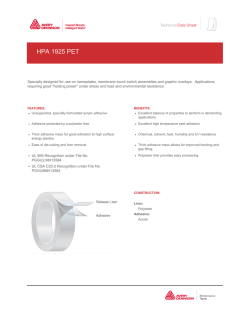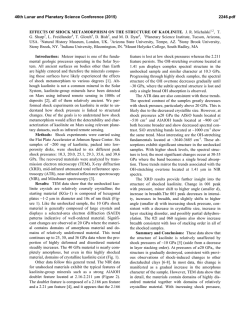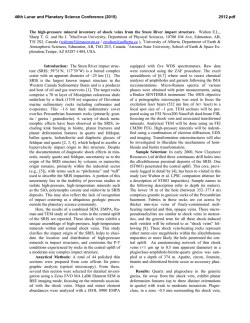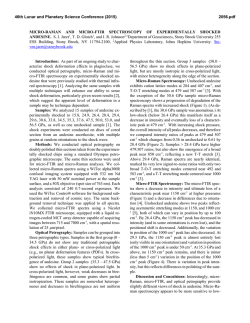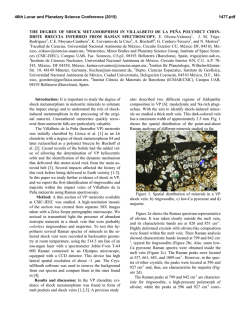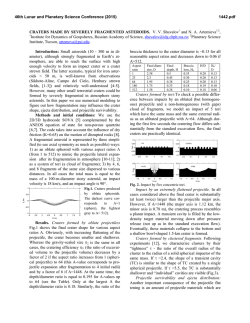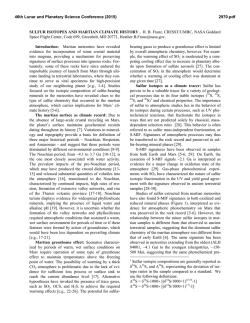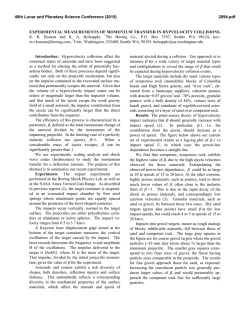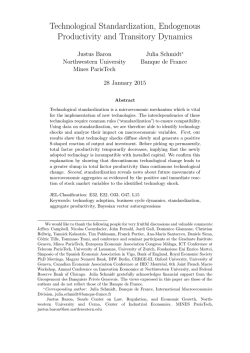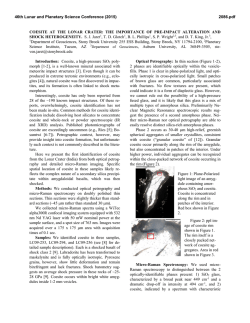
Simulating Dwell Times at High Pressure and Temperature
46th Lunar and Planetary Science Conference (2015) 2289.pdf SIMULATING DWELL TIMES AT HIGH PRESSURE AND TEMPERATURE FOLLOWING AN IMPACT: RELATING THIN SECTION TO SOURCE CRATER. T. J. Bowling1, B. C. Johnson2, and H. J. Melosh1 1Department of Earth, Atmospheric, and Planetary Sciences, Purdue University, 550 Stadium Mall Drive, West Lafayette, Indiana, 47907 [[email protected]], 2Department of Earth, Atmospheric, and Planetary Sciences, Massachusetts Institute of Technology, 77 Massachusetts Avenue, Cambridge, Massachusetts, 02139. Introduction: Martian meteorites represent the only known samples of the Martian surface available for in depth study, at least until a series of proposed NASA missions succeed in collecting and returning pristine material. The Martian meteorite ‘Tissint’ is a sample of particular interest for several reasons: 1) cosmic ray exposure ages suggest it was ejected relatively recently from the surface of Mars (0.7 ± 0.3 Mya) [1]; 2) It contains a wide diversity of high pressure mineral assemblages, which suggest it was ejected by a fairly large impact [2]; and 3) it contains organic carbon with isotope signatures suggestive of, but not conclusive of, biological activity [3]. Because of this, the ability to relate the Tissint sample back to the crater that ejected it, and its source terrain, is paramount. Study of high pressure polymorphs (HPPs) within the Tissint sample have been used to infer a source crater size of 45 to 180 km diameter [2]. However, the set of assumptions used to relate the size of crystals in the Tissint sample to the size of the projectile that induced their formation is highly simplistic, and warrants further consideration. Using very high-resolution numerical models, we explore spatial variations in the time target rock ejected by impacts spends in high temperature and pressure regimes conducive to the formation of HPPs. This potentially new and previously unexploited detail in impact shock metamorphism provides a critical link between laboratory studies of impact ejecta and the cratering events that modified and excavated that ejecta. Relating HPPs to Impactor Diameter: Hypervelocity impacts are some of the most energetic processes in the Solar System. When a high-speed projectile collides with a target, it produces a shock wave that compresses material to extremely high temperatures and pressures [4]. In geologic media, these high P and T conditions can cause phase transformations in minerals, producing HPPs. Shortly after an impact shock compresses material to high pressure, a rarefaction wave, propagating from the free surface at the back of the projectile, arrives. As this release wave passes, both pressure and temperature relax isentropically to a final, post-shock state. At this stage the formation of most HPPs will cease. Assemblages of HPPs, each of which form under different pressure and temperature conditions, are commonly used as a diagnostic tool to understand both the peak and average pressures that occur following an impact shock [5]. The size and trace element distribution of various HPPs [2,6] can provide information about the amount of time a rock has spent above a given temperature and pressure, which we refer to here as ‘dwell time’. In meteorites, dwell time can be used to infer parameters of the impact event that excavated, ejected, and delivered specimens to Earth [2]. Specifically, they allow one to estimate either the diameter or the velocity of the original impactor. Studies [2,6] that attempt to use observed mineralogy to estimate originating impact characteristics make a very basic assumption about how to relate HPP derived dwell time (τ) to impact velocity (v) and projectile diameter (D): D=τxv (1) This equation for τ is the same as the timescale of the impact ‘contact and compression’ stage [4], and its use seems to stem from an order of magnitude estimate of shock rise time [7]. In addition, this relation neglects a point of fundamental shock physics: the dwell time τ is dependent on the pressure and temperature threshold of interest. That is to say, if a volume of rock ejected by an impact spends 10 µs above 35 GPa and 3000° K, it may spend considerably longer than 10 µs above 20 GPa and 1500° K. In short, while Eq. 1 an order of magnitude relation between dwell time and projectile diameter, the application of nuanced numerical studies of shock compression, decompression, and ejection can allow for a more accurate determination of the size of the Tissint source crater. Numerical Modeling: We use the iSALE shock physics code [8-10], a hydrodynamics code oriented towards accurately addressing impact and shock processes in geologic materials, to reproduce an impact scenario similar to that proposed in [2] as the source of HPPs in Tissint. Our model consists of a 10 km diameter dunite projectile colliding vertically with a dunite half-space target at 7 km s-1. We address Material thermodynamics using the ANEOS equation of state [11]. To accurately reproduce shock effects we use an extremely high resolution computational mesh with grid spacing of 12.5 m. Each model cell contains a massless tracer particle that follows material flow while recording pressure and temperature fluctuations. 46th Lunar and Planetary Science Conference (2015) 10 50 40 Peak Pressure [GPa] Kilometers 5 30 20 0 10 -5 0 5 10 Kilometers 15 10 0 5 4 Kilometers 5 3 2 0 Dwell Time [s] Results: Figure 1 shows provenance plots of peak pressure experienced and dwell time above 1 GPa following impact in the region from which high speed ejecta originates. The pressure cutoff of 1 GPa for dwell time calculations was chosen because it is low enough to encompass most of a shock pulse yet considerably larger than ambient isostatic pressure throughout the mesh. The size of ringwoodite (a HPP of olivine) crystals in Tissint suggest a dwell time at high pressure of ~ 1 second [2]. The widespread presence of melt pockets and diversity of HPPs in the sample additionally suggest peak pressures between 25 and 40 GPa [3]. There is only a small region in the near surface that experiences this combination of peak pressures and dwell time, suggesting Tissint was likely excavated from a relatively shallow initial depth near the point of impact. Discussion: The most important characteristic to note in the dwell time distribution of Fig. 1 is that τ varies considerably with distance and depth from the impact point. By contrast, the use of Eq. 1 assumes that dwell times are constant over the entire domain (in this case, τ = 1.4 seconds). Additionally, isobars (lines of equal pressure) and isochrons (lines of equal dwell time) have markedly different spatial distributions. This means that there will be material of a given peak pressure ejected by an impact with a range of high pressure dwell times. Because dwell times should scale linearly with impactor size [4] while maintaining the same spatial pattern, material that has spent a relatively long interval at high pressure and temperature can be ejected by much smaller impacts than previously inferred. It appears necessary, then, to consider additional parameters such as peak pressure, temperature, ejection velocity, and fragment size in order to constrain projectile size based on HPPs. Simple analytic relations are not sufficient for this, and detailed numerical models must be used in their place. This simulation presented here assumes 1) vertical impact angle; 2) a single impactor size; and 3) a single impact velocity that is on the low end for Martian impacts. In addition, we do not investigate important second order effects such as the crushing of pore space in the target, which can drastically change the distribution of shock pressures and temperatures [12]. The effects of variations in the above parameters will be the subject of future work, with the goal of more accurately constraining searches for the origin craters of Martian meteorites such as Tissint. Acknowledgements: We gratefully acknowledge the developers of iSALE including Gareth Collins, Kai Wünnemann, Dirk Elbeshausen, Boris Ivanov, and Jay Melosh. 2289.pdf 1 -5 0 5 10 15 0 Kilometers Figure 1: Peak pressures reached (top) and dwell time at pressures above 1 GPa (bottom) following the impact between a 10 km diameter impactor and a Martian like target at 7 km s-1. Peak pressures and dwell times are calculated using massless tracer particles that follow material flow through the computational grid, but are plotted at their locations at the moment of impact. References: [1] Aoudjehane H. C. et al. (2012) Science, 338, 785. [2] Baziotis, I. P. et al. (2012) Nature Comm., 4, 1404. [3] Lin, Y. et al. (2014) MAPS, 49, 12. [4] Melosh, H. J. (1989) Oxford University Press, 245p. [5] French, B. M. (1998) LPI Contrib., 954. [6] Beck, P. et al. (2005) Science, 435, 1071. [7] Melosh, H. J. (1984) Icarus, 59, 324. [8] Amsden, A. et al. (1980) LANL Report, LA-8095. [9] Collins, G. S. et al. (2004) MAPS, 39, 217. [10] Wünnemann, K. et al. (2006) Icarus, 180, 514. [11] Benz, W. et al. (1989) Icarus, 81, 113. [12] Bland, P. A. et al. (2014) Nature Comm., 5, 5451.
© Copyright 2026
